October 17th, 2012 § § permalink
SJ here. My heart has been echoing with that bubbling, pitter-pat effervescence of joy that makes me want to run to the hilltops and shout out: I AM IN LOVE!!! Well, I am. Completely and totally smitten with the absolutely wonderful Court Street Grocers which opened in late 2010 and which I am just now discovering right here in my backyard of Carroll Gardens, Brooklyn (perhaps the best neighborhood in the entire universe).
Court Street Grocers is half a specialty grocer and half an über casual breakfast / sandwich spot (that also serves dinner once a week). Where much of Brooklyn’s new food culture prides itself, in both positive and negative ways, on a seriousness of intent — chefs in Abraham Lincoln beards and suspenders hand churning artisanal butter and restaurants so painstakingly dedicated to the locavore movement that they will only serve lettuce grown on the roof of their own spot — Court Street Grocers just seems to love food and have a profound joy in sharing it. Witness the grocery section: neat shelves lined with stuff that I, or my family or any of my friends would have chosen: weird mustards from West Virginia, regional hot sauces, Goldenberg’s peanut chews, jars of Brooklyn made Kim Chee, New Orleans Ice Coffee concentrates, Japanese Kewpie brand mayonnaise, Hatch Green Chili Sauce, top shelf Canned Tomatoes, great milk, NY state apples and seasonal veggies, and much much more; a high – low approach that completely won me over and had me going condiment mad like a porn maven in video shop going-out-of-business sale.
And then there are the sandwiches….It is as if the mad scientists of Court Street Grocers pinpointed the fertile imagination of the returning-home-late-at-night, semi drunken, famished chef who is only out to please his own belly. MAN!!! Let’s review the numbers I have tried: The “Little Shonda” — Dark, toasted pumpernickel bread, slathered with Durkee Famous Sandwich Sauce, softly scrambled eggs, top quality pastrami, melted swiss and pickled green tomatoes. The “Mother-in-Law” — A cibatta loaf stuffed with braised heritage beef short ribs, kim chee, roasted broccoli and lots of mayo. The “Media Noche” – Roasted Pork Shoulder, Heritage Foods Ham, Swiss Cheese, Mayo, Mustard, Gus’ Full Sour Pickles, on Brioche, which is. more or less, the greatest Cubano Sandwich I have ever tasted. And finally, a toasted cheese sandwich of Cabot Cheddar, Apple Butter on a superb 10 grain Pullman Loaf. Everything just wonderful and they have loads more sandwiches that I have not gotten around to tasting yet. And, just to rule a bit more, they also have great coffee. These sandwiches can be eaten in a plain, but perfectly comfortable, dining room or taken out. There is also a $35 prix fixe dinner that is served every Friday with 2 seatings that you have to reserve on-line. I have looked at the offerings and they seem to be as wonderful as the lunch and breakfast menus — simply put, food that you want to eat.
The owners (there are 3 of them, maybe 4?) of this wonderful establishment hang out by the cash register, seemingly the happiest group of people you can imagine. I saw one of them walking down Court Street once, simply floating with joy as every other person that walked by greeted him with words and smiles. These are people that are having fun at their jobs — they are thrilled to be part of their community, they are having a great time and they know everything about what they are selling and have definitely enjoyed it all. I am so happy that I am lucky enough to be within the sphere of Court Street Grocers and will continue to explore (and report!) on their food.
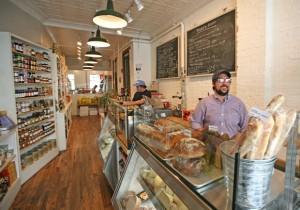
October 10th, 2012 § § permalink
Some 48 years ago (seems like yesterday). HG, BSK, their two adorable children, their live-in mother’s helper and their poorly trained but decorative standard poodle, lived in a 12th floor Upper West Side apartment with dramatic views of the Hudson River and the New Jersey Palisades. A very spacious residence. Big living room. Big, separate dining room. Nice windowed kitchen and pantry. Four bedrooms and three baths (one en suite). The rent: $274 a month (later raised to $292 and a similar apartment in the same building now rents for $15,000 a month). Ah, rent control, you lovely bit of legislation (of course, obtaining this rent controlled paradise involved some bribery, chicanery and corruption). This did not shock HG, a born and bred New Yorker. In those days the Upper West Side was affordable and diverse. There was still a heavy Jewish influence. Big time theater and entertainment folks (Abe Burrows, Leonard Bernstein, Isaac Stern and many more) lived on Central Park West alongside many affluent professionals and business persons. Side streets from Central Park West to Broadway were gritty (except for W. 67th Street, site of the Des Artistes apartment house and many studios of painters and musicians). Riverside Drive and the Avenues and cross streets west of Broadway were filled with intellectuals and creative types who had more brains and talent than money. Forget Greenwich Village. The Upper West Side was the home of professors, critics, novelists, dancers, journalists, composers, actors, musicians and school teachers. Lots of European intellectuals who had fled Hitler and many Holocaust survivors (the little, pale, Nobel Prize winning writer, Isaac Baashevis Singer, who lived on W. 86th Street, often wrote about them). The Heresford (West Side apartment houses often had British names, a touch of Anglophile class) where HG and BSK lived, had much artistic ferment. Among its residents were Peter Boyle (before Hollywood and TV fame); film composer Michael Small, the critic and editor Ted Solotaroff; Gary Null, the health and sex writer, guru and radio personality. There were also some Broadway dancers, the cantor of a major synagogue and lesser artistic lights. The Upper West Side was filled with movie theaters showing art films (the New Yorker, Thalia and Symphony) and plus the first run houses (Loew’s 83rd, the Beacon,etc.). Food was a neighborhood obsession. Zabar’s, of course, but also Murray’s (preferred by some smoked fish aficionados) and Barney Greengrass (unsurpassed sturgeon). Middle European restaurants like Eclair and dairy restaurants like Steinberg’s and Paramount. Gitlitz’ Delicatessen on Broadway and 78th ( much superior in HG’s informed opinion, to Katz’s, Carnegie or 2nd Avenue Deli). The jewel of the West Side was the Tip Toe Inn (on Broadway near 86th Street). A huge place with a huge menu. Everything was delicious and inexpensive (the New York Public Library has a nice collection of old menus….Here’s a link to Tip Toe’s 1954 menu. Be astonished). There was a rotisserie in the Bretton Woods Hotel (86th and Broadway) that barbecued ducks and chickens. Sunday dinners for HG and BSK often featured one of those juicy, crisp skinned ducks and an avocado-sweet onion-sliced orange salad. Chinese restaurants were clustered around Broadway and 96th and they were very good (the first Szechuan restaurant in New York was on Broadway and 95th). There were also some Cuban/Chinese places where you could get good shrimp dishes plus Moros y Cristianos (black beans and rice) Fairway didn’t exist but for those who liked to eat at home there were butchers like Endicottt Meats and Nevada Market (where you could get some exotic stuff including bear, in season). Good bakeries. Mom and Pop greengrocers. Citarella’s for fish. Broadway Nut Shop for sweets. Daitch Dairy (79th and Broadway) for tub butter and cheese. Bretton Wood Rotisserie for barbecued ducks. HG and BSK were not plutocrats but could afford all of these good things. Yes, the Upper West Side had lots of junkies, hookers, muggers and burglars. Their presence made West Siders feel superior to residents of the antiseptic Upper East Side. Now, let HG make you young folks really jealous. HG, BSK and family spent all summer plus spring and fall weekends at their Fire Island home. Built atop a dune it had panoramic views of the Atlantic Ocean and Great South Bay sunsets. The family bought it for $40.000. HG’s first Fire Island house (in 1959) cost $4,000 ($1,000 for land and $3,000 for two bedrooms, bathroom, kitchen, living room and deck). In 1960, HG added two more bedrooms, another bathroom and additional decking. Cost: $2,000. That’s right. The numbers for these Fire Island properties are correct. Read and weep.
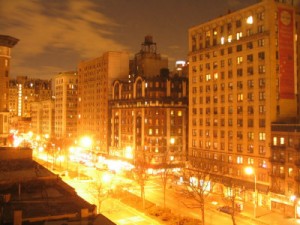
October 9th, 2012 § § permalink
Bobby Short and Mabel Mercer are in the Great Golden Cabaret In Heaven. Two New York perennial cabaret venues — Oak Room at the Algonquin and Feinstein’s at the Regency — are closed or about to close. That leaves only the Cafe Carlyle as the last of the sophisticated New York supper clubs. These supper clubs were where the voices and songs of Mabel Mercer, Cole Porter, Rodgers & Hart, Harold Arlen and Noel Coward were idolized and celebrated. Where once hip folks of all ages went to those uptown Supper Clubs, the patrons now are increasingly ROF’s (Rich Old Fogeys) — obviously, a diminishing market. According to reports, the supper club scene in New York has shifted downtown with an emphasis on irreverence, drag and transgender performers. In this age of pornographic saturation, the old fashioned, bittersweet, romantic lyric seems a bit old fashioned. During the 50’s and 60’s there were scores of supper clubs in mid-Manhattan. Nelly Lutcher sang earthy tunes. Ted Straeter exemplified world weary sophistication. Spivy (a one name performer like “Hildegarde” and “Liberace”) and Dwight Fiske were queen and king of the double entendre (very tame stuff compared to much of today’s music and stand-up comedy ). HG’s favorite was Laurie Brewis who held forth at the Hotel Earle on Waverly Place in Greenwich Village.
During the 50’s, a date night for HG often consisted of martinis at Jack Delaney’s bar, big platters of seafood paella and a pitcher of sangria at one of the Village’s many good Spanish restaurants, a European movie at the Art movie theater — and then on to Brewis and Earle at midnight. The New Yorker Magazine described Laurie Brewis as “a fey bistro version of Noel Coward,” “The London Edition of the Show Business Encyclopedia” and a “bouncing Englishman playing his London portfolio and bringing back the tunes that everyone but he has forgotten” Laurie Brewis and his Piano. HG, his snifter of cognac, his Marlboro cigarette, his shapely female companion of the evening. Pleasant memories. Needless to say, HG always wore a shirt, tie, well pressed suit and shined shoes during these revels. One dressed to dine and date. Jeans were apparel for plumbers and cowhands.
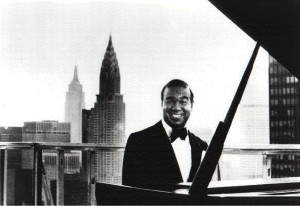
October 5th, 2012 § § permalink
The great food writer, Waverley Root, once defined cuisines by the oil or fat they used in cooking — lard in Germany; butter in Paris, northern France, northern Italy; olive oil in the Provence, southern Italy and most countries bordering the Mediterranean. In the Belmont neighborhood of The Bronx where HG spent his very early childhood, there was a cooking divide between the predominantly Italian population and the Jewish minority. Olive oil, of course, was an Italian staple. HG’s Jewish Mom never used it. Chicken fat was used for cooking and often covered bread rather than butter. HG’s Mom also used a strange substance called Nyafat for frying. Nyafat was pareve — that is it was approved by rabbinical authorities for frying both meat and dairy products. Don’t know why HG’s Mom used it since she was not strict about observing Jewish dietary laws. She used Crisco or Spry for frying sometimes but usually relied on bubbling chicken fat. Butter was used for frying blintzes.
There was also a shopping divide in the neighborhood. HG’s Mom shopped on busy, noisy Bathgate Avenue for chicken, fish, fruit and vegetables. Bathgate Avenue was known for Jewish merchants, bargains and strenuous haggling. Bathgate Avenue is no longer a low end retail venue. It is now a city-subsidized industrial “park.” Italian women shopped on Arthur Avenue and Arthur Avenue (thank you, culinary gods) has remained unchanged over the years and is still one of New York’s best shopping areas for Italian food. Interestingly, one of the great stores on Arthur Ave for Italian food stuffs is a Jewish Shop (marked with a beautiful mosaic of a Star of David) called Teitl Brothers which has been there since 1915. Arthur Avenue butcher shops (with rabbits, whole lambs and piglets hanging in the windows) always fascinated little HG when HG’s Mom made one of her infrequent visits to the Avenue (she fancied the bread and pignolia cookies found there). The only other cultural interchange recalled by HG was HG’s Father swapping his home made cherry brandy (Vishniak) for a neighbor’s home made red wine. Belmont has remained an Italian (and newly Albanian neighborhood), proud of its ethnicity, culture and cuisine. Every weekend, nostalgic Italians from the suburbs (as well as every type of New Yorker and suburbanite) visit Belmont and Arthur Avenue to get a taste of what The Bronx used to be. And, on Arthur Avenue that taste is redolent of olive oil, tomatoes and garlic.
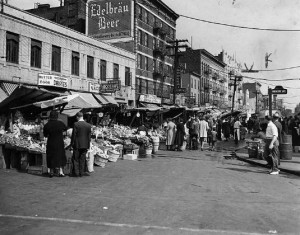
September 30th, 2012 § § permalink
HG has had a long standing love affair with Manhattan’s Chinatown. It all began when eight-year-old HG and his beloved older sister, the late Beulah Naomi K., would climb the steep steps at Fordham Road in The Bronx and ride the scenic 3rd Avenue Elevated train (fare — 5 cents) all the way to Chatham Square in Chinatown. Little HG was fascinated. The strange language. The exotic (to little HG’s eyes) people. The vast variety of food being sold in shops, outdoor stalls and by itinerant vendors. And, the restaurants. Ducks hanging in the windows. Fish swimming in tanks. Barbecue experts slicing pork. At first, HG and sister were timid eaters — won ton soup, chicken chow mein, almond cookies for dessert. Ridiculously cheap, of course — 20-25 cents. But, the two fledgling gourmands quickly became more adventurous. Shrimp in lobster sauce. Roast pork over rice. Moo Goo Gai Pan and much much more. In his late 20s (some 56 years ago!) HG discovered dim sum. Nom Wah on Doyers Street was the only dim sum restaurant in Chinatown (now there are scores). HG became an addict and every Sunday morning devoured Nom Wah dim sum while reading the hefty Sunday edition of The New York Times. (Blessedly, Nom Wah has been revived by a new generation of the original owners and they have maintained the wonderful charms of the original decor while giving the place a much needed spruce up.The dim sum are as good as ever). HG realizes that Flushing (and maybe even Brooklyn’s Sunset Park) have replaced Chinatown as the great centers of New York Chinese cuisine. HG and BSK have rented a Chinatown apartment for one week this December and there will be a thorough exploration of the current Chinatown food scene. HG relies upon three Chinatown culinary guides: SJ, David Sietsma of the Village Voice and the blog, lauhound.com. HG remembers when Chinatown only had Cantonese cuisine. Now there are many restaurants featuring regional cooking — Chiu chow, Fujianese, Szechuan, etc. Dumpling and noodle restaurants (many strictly hole-in-the wall) have proliferated. There are many Vietnamese restaurants, including an HG favorite, Nam Son. Chinatown has expanded into the Lower East Side and Little Italy. Mission Chinese, an adventurous California/Chinese venture, has a pastrami dish on its menu. Does this represent a challenge to Katz’s?
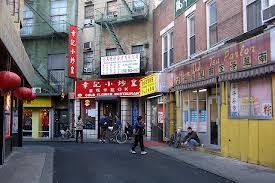
September 17th, 2012 § § permalink
Mark Bittman had a good article recently in the New York Times expressing his displeasure with expensive, elaborate meals at New York restaurants run by “celebrity” chefs. Unwelcoming atmosphere. Fussy food. A $200 price and you don’t have a good time. Antithetical to this are the three New York restaurants run by HG’s daughter, Victoria, and her chef/partner/husband Marc Meyer. The restaurants are Cookshop (Chelsea), Hundred Acres (Soho) and Five Points (Noho). Do not accuse HG of nepotism, favoritism or clouded judgment. In matters of cuisine (if nothing else) HG is the soul of honor, objectivity and probity. Victoria’s restaurants don’t need HG’s aid. They are busy, successful places with lots of steady customers and many famous faces among the diners. The food? Strictly locavore. Generous portions. Robust flavors. Affordable prices. Very good wines and splendid, beautifully shucked oysters. Brunch is a special treat. Check out the restaurant websites. You’ll get hungry. When you go, say HG sent you.
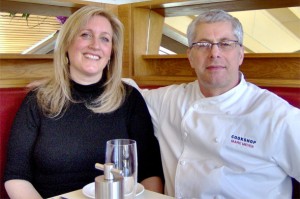
September 12th, 2012 § § permalink
Following yesterday’s posting, Hungry Gerald followers have expressed curiosity about the cuisine in the tiny, cramped, non-air conditioned Rockaway rooming house occupied by HG’s family during the steamy summers of the Great Depression. Sour cream (smetenya, HG’s Mom called it, harking back to her Belorussian roots), was the basic foodstuff. Big spoonfuls were mixed into Mom’s cold and flavorful beet borscht and sorrel soup (schav). Main dish at many dinners was simply a bowl of boiled potatoes with sour cream. The family also ate bowls of sour cream with chopped radishes, scallions and cucumbers. Sour cream adorned Mom’s blintzes (crepes stuffed with pot cheese or peppery mashed potatoes). Sour cream was served with kasha varneshkes (buckwheat groats and butterfly pasta). Best of all were bowls of strawberries, raspberries, blueberries and blackberries adorned with sour cream. Meat didn’t play a big role in the Rockaway diet (except for salami and eggs in a pancake style). Lots of fried flounder. Mom dipped the fish in beaten egg and rolled them in bread crumbs before popping them into an pan of sizzling Crisco. This was served with Mueller’s Spaghetti and Mom’s very rudimentary tomato sauce (HG loved it). Tuna and sardine salads were basics. A truck manned by a Long Island farmer pulled up on the Rockaway block daily loaded with fresh tomatoes, lettuce and seasonal vegetables. Fortunately, he always had a load of just picked corn and HG managed to eat a ton of it dripping with butter. The drink was always beer fetched at the beginning of dinner from Reidy’s Saloon on the corner (in later years, HG had an Abie’s Irish Rose romance with the proprietor’s lovely daughter). Yes, HG (at the age of six) drank beer with his elders. It was considered a healthy drink unlike the sugary sodas that were not allowed on the HG table. HG had a joyous errand at the end of dinner. It was his job to get a quart of ice cream (35 cents) at Barney’s Ice Cream Parlor. This was hand churned deliciousness that Barney scooped into a container. HG had to race back home with the ice cream before it melted. Anticipation gave the little fellow winged feet.
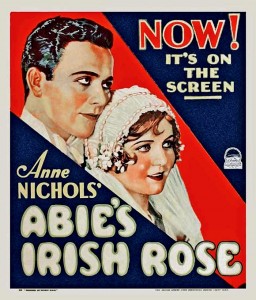
September 11th, 2012 § § permalink
When HG was a little lad during the Great Depression, the HG family of four (and sometimes five) spent summers in a Rockaway Beach boarding house. Two rooms (a kitchen/”dinette” and bedroom connected by a foyer. Mom and Pop slept in the bedroom. Sister slept in the foyer. HG slept on the kitchen floor. When brother occasionally joined the family, the kitchen table was shoved to a side and he joined HG on the kitchen floor. The rudimentary sleeping pads were rolled up in the morning and stored under the parental bed. Toilet was in the hall outside the apartment and was shared with another family. The arrangement encouraged alertness. Showers were in the basement of the boarding house and the water had two temperatures — cold and very cold. The summer season began July 1 and ended the day after Labor Day. Rent: $25 for the season. Did HG (or any of the other family members) feel deprived because of the crowding and primitive facilities? No. It was heaven. Life was lived (during the day) on the beach and in the sea and (at night) on the boardwalk cooled by salt air breezes. HG’s father commuted to the hot city and (rain or shine) upon his return spent an hour being refreshed in the Rockaway surf. The kitchen had no refrigerator. It had an ice box (serviced by a muscular Italian ice man named Vito). There was a basin beneath the ice box to contain the melting ice and it was little HG’s responsibility to make sure the basin was emptied before it could overflow. HG was dedicated to that task. As a reward, HG could use the ice pick to chip a bit of ice for a cooling treat. HG’s Mom would often chip some chunks of ice to put in her bowls of pink, cold beet borscht (best cold summer soup in HG’s long culinary experience). The ice pick got a lot of use. During that same time period ice picks were being used for lethal purposes by the Murder, Inc. killers from Brooklyn’s Brownsville neighborhoods. The renowned Jewish assassin, “Pittsburgh Phil” Strauss, would plunge an ice pick into his victim’s ear or temple. He was so deft that many medical examiners assumed the victim died of a cerebral haemorrhage. According to a recent New York Times story, the ice pick (after a decades long absence) has reemerged as a an anti-social utensil. It is now a weapon of choice for many Bronx street gangs. Obviously, these thugs have an affection for retro artifacts.

September 8th, 2012 § § permalink
Some great dishes seem to have disappeared from restaurant menus. Mozzarella in Carozzo, a delicious fried mozzarella and bread confection (often enhanced by anchovy sauce) is gone from Italian restaurants in New York. Hard to find clams casino or clams oreganato. Pork chops with vinegar peppers was a staple at the late, lamented Delsomma and other Italian eateries. Gone except for venerable Patsy’s on West 56th. HG misses boeuf bourginoun and plain, old American beef stew. What could be better on a cold day (with a big dollop of buttery mashed potatoes or egg noodles) ? Ditto really good meat loaf, which, except for the dish’s re-invention at many a New York hot spot, has gone the way of a 25 cent cup of coffee. HG sees $40-$45 veal chops on menus. Fuhgeddabout it !! HG wants those hearty, bargain treats.

August 25th, 2012 § § permalink
This week The New York Times reported the passing (at 87) of Robert Treboux, the proprietor of the frozen-in-time French bistro, Le Veau D’Or located in New York’s Upper East Side. Sad news. Treboux was a gracious man who kept alive old fashioned, French bistro cooking. Nothing ever changed at Le Veau D’Or. Not the decor. Not the menu. Not the gracious service. Only the clientele, which got older every year but remained faithful to this temple of quenelles, tripe, brains in black butter and long simmered butter and wine sauces. When HG had offices on Madison Avenue and 60th Street HG lunched there frequently. HG was served a giveaway of mussels in mustard sauce. Then there was an ample plate of sausage in crust with warm potato salad. Crocks of Dijon mustard (the real, tongue tingling stuff before pallid Grey Poupon arrived on the scene) and cornichons. Then a serving of brains in black butter with crusty bread and parsley-flecked boiled potatoes. A wedge of ripe Camembert helped HG finish his luncheon bottle of Beaujolais. In cold weather, HG often dipped into a huge cassoulet or a Provencal pot roast redolent of garlic, tomatoes and fresh herbs
Two years ago, HG lunched at the restaurant with SJ in tow. Treboux was there to give a pleasant welcome. At the end of the meal, HG encountered Elaine Kaufman of Elaine’s Restaurant and settled down to an afternoon of cognac and gossip. Elaine died a few months later. And, now Treboux. Thus, does HG’s New York fade into oblivion.










